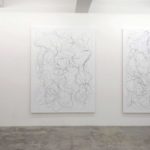
©石原友明
Dates: November 29, 2014 – January 18, 2015
Venue: MEM map
open hours:12:00-20:00 closed on Mondays (open on Jan. 12), closed on Jan. 13.
tel. +81-(0)3-6459-3205
Opening reception : November 29th (Sat.) 18:00〜 at MEM
Artist talk : January 17 (Sat.) 18:00〜 at MEM
Guest speaker, Kazuhiro Yamamoto (Senior curator, Tochigi Prefectural Museum of fine Arts)
In this exhibition, Tomoaki Ishihara presents a series of canvas works titled Bathroom picture, which explore the theme of “self-portraiture”. After priming the canvas with gesso, the image is rendered on to the canvas surface with a printer using special ink.
This series, which appear to be monochrome drawings of curved lines, are images of the artist’s collected hair that has been scanned, converted into vector data (quantified), and recomposed as two-dimensional work——in other words, a self-portrait of the artist. Ishihara published a short novel in the 1990s titled “Given: A Blind Man Meets an Invisible Woman at an Art Museum”, depicting an encounter between a blind man and an invisible woman, who’s sole existence is based, respectively, on “being seen” and “seeing”, from which he draws a passage for this exhibition:
…A strand of hair falls to the ground——from her body, now completely transparent. Once separated from the body, little by little, the hair begins to lose its transparency. Gazing at the hair, now visible, dead and no longer a part of herself, she somehow felt dizzy with a reversed sensation, as though she had come across her very own, long forgotten, living body…
(Given: A Blind Man Meets an Invisible Woman at an Art Museum, 1993)
Once hair sheds and leaves the body, it becomes undistinguishable and anonymous. However, at the same time, on a micro level, the individual can be identified through DNA testing. Through scanning and quantifying, the hairs become abstracted and distanced from the original body. Also, since vector graphics allow images to be forcibly enlarged or reduced without sacrificing the quality of the image, the idea of a “life-size” image loses its meaning. By “re-stabilizing” the data converted from a body part on a canvas of a certain size, Ishihara claims to be “re-embodying, by giving what was once his body part, a new skin and body”. By employing, the old format of canvas painting when undertaking this process, the digital world——what could be considered most distant from the body, is connected to the realm of the hand-made, rooted in the use of the physical body.



 Tomoaki Ishihara |Saccade and Afterimage
Tomoaki Ishihara |Saccade and Afterimage  On Mono, Koto, and Kotoba – Eight Perspectives
On Mono, Koto, and Kotoba – Eight Perspectives  Tomoaki Ishihara |Flies and Frankenstein
Tomoaki Ishihara |Flies and Frankenstein  On Mono, Koto and Body – Six Perspectives
On Mono, Koto and Body – Six Perspectives  Tomoaki Ishihara “34 LIGHT YEARS”
Tomoaki Ishihara “34 LIGHT YEARS”